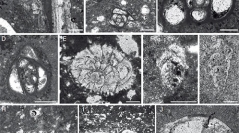

 Geodiversitas
30 (1) - Pages 165-179
Geodiversitas
30 (1) - Pages 165-179In numerous carbonate platforms of western Mediterranean (Algeria, Morocco, Spain, etc.) the deposits of the Terminal Carbonate Complex, directly following the Porites prograding reefs, are characterized, on the reef slopes and in distal position, by a white micritic deformed limestone. In Algeria, near Oran, the fossiliferous content of this limestone, that can contain gypsum masses, has been inventoried. According to layers and to the different outcrops, the dominant fauna is represented by oysters, with the species Neopycnodonta navicularis forming aggregations, or pectinids as Aequipecten macrotis. The echinoid Brissopsis lyrifera is also present. The other fossils collected are internal or external casts and their determination at the specific level is consequently difficult. Thus, among the other molluscs, have been sampled several specimens of Chama gryphoidses, Ctena decussata, Cardiidae, Lucinidae, Gibbula sp., Alvania gr. venus, Thericium cf. europeum, Bittium reticulatum, Conus cf. dujardini, Vermetidae, Epitonidae, Nassariidae, etc. Small red algae aglomerates are not rare. Sponges are represented abundantly by omnipresent siliceous spicules, giving locally a true spiculite. This association testifies marine conditions in a turbid quiet environment that can reach circalittoral environment. Such population is very similar of the one observed in the other platforms but also of the one of intragypse clayey limestones of Spain. These facts testify a continuity of a biota well adapted of poorly oxygenated bottom and raise questions about the significance of certain messinian gypsum lenses.
Carbonate platforms, Messinian, Mediterranean, Algeria